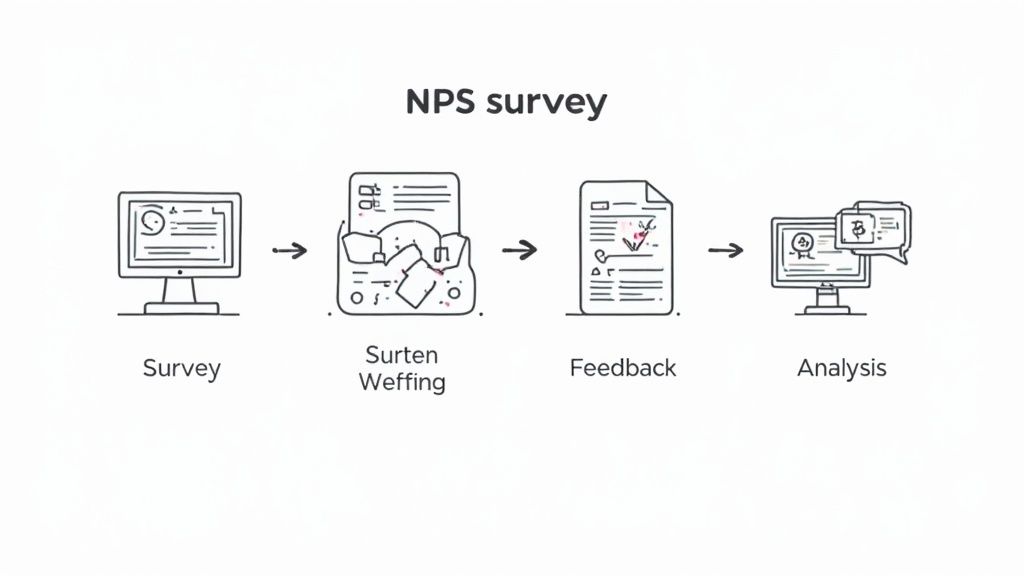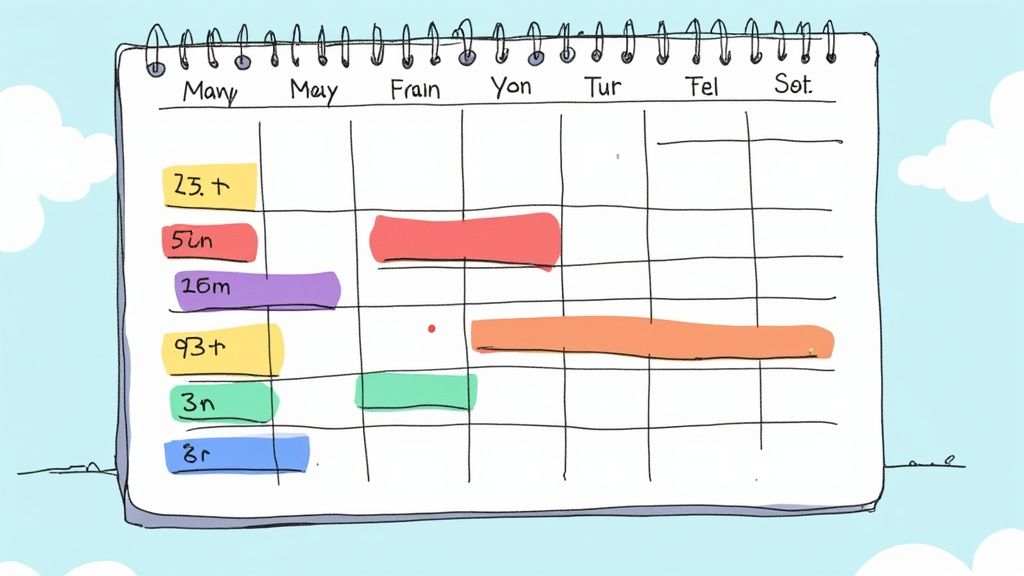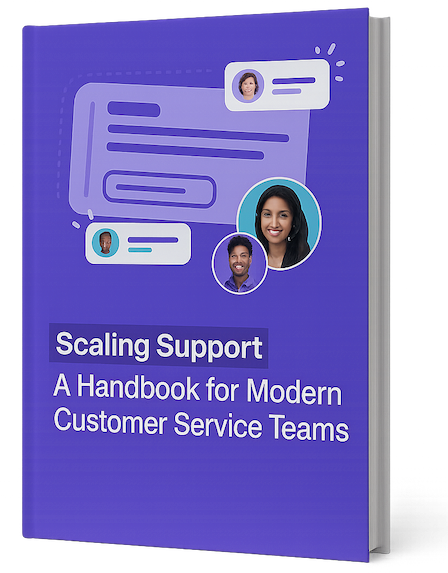The Net Promoter Score (NPS) is often misunderstood as just another business metric. In reality, it reveals deep insights into what drives customer loyalty and business growth. Companies that use NPS effectively see real results – those with top scores typically grow at more than twice the rate of competitors. This is because satisfied customers tend to stay longer, recommend the business to others, and spend more over time.
Why the Promoter-Passive-Detractor Framework Matters
Breaking customers into promoters (9-10), passives (7-8), and detractors (0-6) provides much more value than a simple satisfaction score. This framework helps companies spot specific problems and opportunities. For example, analyzing detractor feedback often uncovers fixable issues in the customer experience, while studying promoter responses reveals what delights customers most. With these clear segments, teams can focus their efforts where they’ll have the biggest impact on building customer loyalty.
Beyond the Score: Combining NPS with Other Metrics
Think of NPS like a vital sign – it’s important but works best when measured alongside other indicators. Just as a doctor looks at multiple factors to assess health, combining NPS with metrics like customer lifetime value, churn rate, and customer effort score creates a fuller picture. For instance, if you have high NPS scores but customers aren’t spending much over time, it may mean they like individual interactions but don’t see long-term value in your offering. Looking at multiple metrics helps uncover these deeper patterns that a single score might miss. You might be interested in: How to master sitemaps.
Real-World Examples of NPS Success
Many companies have achieved remarkable results by acting strategically on NPS data. Some have implemented systems to quickly address detractor feedback, turning unhappy customers into loyal fans. Others use NPS insights to guide product improvements, ensuring new features align with what customers value most. These success stories show that NPS becomes truly powerful when companies move beyond measurement to take meaningful action. The key is using the feedback to make specific, customer-focused improvements rather than chasing a higher score for its own sake.
Designing Surveys People Actually Want to Complete

Now that we understand why NPS matters, let’s focus on creating surveys that customers genuinely want to complete. A thoughtfully designed survey does more than just collect responses – it encourages meaningful participation and uncovers real insights that can improve your business. This means carefully considering your question format, making the experience personal, and valuing your customers’ time investment.
The Psychology of Engaging Survey Design
Think about the last time you received a generic “Dear Valued Customer” email – did you feel motivated to open it? Probably not. The same principle applies to surveys. When you address customers by name and reference their specific experiences with your product or service, response rates typically increase. People are more likely to engage when they feel personally invested. Frame your survey as an opportunity for customers to help shape future improvements, rather than just another data collection exercise.
Crafting Questions That Get to the Heart of the Matter
While the standard NPS question about likelihood to recommend is essential, the real insights often come from thoughtful follow-up questions. Rather than asking “Why did you give us this score?”, consider questions tailored to different score ranges:
- For Promoters (9-10): “What do you love most about [product/service]?”
- For Passives (7-8): “What could we do to improve your experience?”
- For Detractors (0-6): “What was the primary reason for your score?”
This focused approach helps you gather specific, actionable feedback while showing customers you truly want to understand their perspective.
Respecting Your Customer’s Time: Keeping It Short and Sweet
Studies consistently show that shorter surveys get more responses. While detailed feedback is valuable, keep your NPS surveys brief – aim for a completion time under five minutes. Use clear, simple language and limit yourself to only the most essential questions. Think of it as a quick check-in with a friend – get to the point while still being friendly and engaging.
Optimizing for Mobile: Meeting Customers Where They Are
With most people accessing content on their phones, your NPS survey must work smoothly on mobile devices. Make sure text is readable, buttons are easy to tap, and the overall experience feels natural on smaller screens. Consider embedding surveys directly in your app or website for seamless integration. When you make it easy for customers to share feedback wherever they are, you’re more likely to hear what they really think.
Mastering the Art of Survey Timing and Distribution

Getting your survey timing and distribution right is key to collecting valuable feedback and engaging more customers. A smart approach involves careful planning around when and how you reach out to customers. Let’s explore how to effectively gather insights through both relationship and transactional surveys.
Combining Relationship and Transactional Surveys for a Complete Picture
Think of relationship surveys as regular check-ups with your customers – they help you understand overall loyalty to your brand. You might send these quarterly or twice a year to gauge general sentiment. In contrast, transactional surveys focus on specific moments, like when someone makes a purchase or uses your SupportMan help center. The feedback is immediate and tied to that particular interaction. Using both types gives you a well-rounded view – you’ll see both the big picture of customer relationships and detailed insights about specific touchpoints.
Timing is Everything: Finding the Sweet Spot for Survey Delivery
Getting the frequency right takes some fine-tuning. Send surveys too often and customers may tune out, leading to fewer responses. Space them too far apart and you’ll miss valuable feedback opportunities. For transactional surveys, it’s best to ask for feedback right after the interaction while the experience is fresh. For example, following up immediately after a customer service interaction helps pinpoint what worked well or needs improvement. With relationship surveys, a quarterly or bi-annual schedule often works well to track longer-term trends.
Strategic Distribution Channels: Reaching Your Customers Where They Are
Email is common but shouldn’t be your only option. In-app surveys work great for active users, SMS can grab attention for time-sensitive feedback, and social media polls help reach a wider audience. The most effective channel depends on your customers’ preferences – focus on the platforms where they’re already engaged. This targeted approach helps ensure your surveys reach customers when they’re most likely to respond.
Boosting Response Rates with Smart Triggers and Personalized Invitations
Well-timed triggers can make a big difference in survey completion rates. Send transactional surveys right after relevant interactions. For relationship surveys, consider sending them after important milestones in the customer journey. Making the invitation personal – using the customer’s name and mentioning specific interactions – shows you value their input. For instance, when you reference a recent purchase in your survey request, customers are more likely to engage compared to generic messages. This personal touch builds connection and encourages thoughtful feedback.
Turning Raw Scores Into Revenue-Driving Insights
Getting NPS survey responses is just the start – the real value comes from converting those scores into insights that directly improve your business. Rather than simply tracking your overall number, successful companies dig deeper to understand what drives customer sentiment and use those learnings to make meaningful changes. Let’s explore proven ways to extract actionable insights from your NPS data.
Segmenting Responses: Unveiling Hidden Trends
Breaking down NPS responses by customer segments reveals important patterns that the overall score might miss. For instance, you may find that new customers rate you much lower than long-term ones, or that certain product lines consistently get more negative feedback. This detailed view helps you focus improvement efforts where they’ll have the biggest impact. Think of it like a doctor who doesn’t just check temperature but examines all symptoms to make an accurate diagnosis. Similarly, understanding what shapes NPS scores requires looking at the full picture through segmented data.
Analyzing Trends and Connecting the Dots
Tracking NPS changes over time shows whether your customer experience efforts are working. By linking NPS data to business metrics like customer churn and lifetime value, you get a more complete view of performance. For example, if you have good NPS scores but high churn, it may mean customers like individual interactions but aren’t finding lasting value. Looking at these connections helps spot issues and opportunities that might not be obvious from NPS scores alone.
From Passives to Promoters: Targeted Interventions That Work
A key goal is converting passive customers into active promoters. While passives are somewhat satisfied, they could easily switch to competitors. By analyzing their feedback carefully, you can identify specific pain points – maybe they find certain features confusing or feel their needs aren’t fully met. Targeted solutions like personalized outreach or proactive support can help move them toward becoming enthusiastic promoters. The same goes for addressing detractor concerns head-on. If customers consistently mention long wait times or recurring bugs, fixing those specific issues not only reduces detractors but shows you take their feedback seriously. Focusing on these targeted improvements, rather than just chasing a higher overall score, creates lasting customer relationships that drive business growth. The key is viewing NPS as a guide for ongoing enhancements, not just a number to track.
Building a Response-Driving Incentive Strategy

Getting meaningful customer feedback can be challenging when survey fatigue sets in. The good news is that a thoughtfully designed incentive program can boost participation rates while maintaining the quality of NPS survey responses. Success comes from understanding what truly motivates customers to share their feedback and crafting invitations that highlight the mutual benefits of participating.
The Power of Value Exchange: Framing Incentives Effectively
The best incentive programs position surveys as collaborative exchanges rather than one-sided requests. Instead of simply offering a reward, show customers how their input directly shapes improvements to the products and services they use. For example, try framing your invitation as a chance for customers to “help shape the future of [your product/service]” rather than just asking them to “complete a survey.” This approach connects with customers who want to know their opinions matter and make a real difference.
Choosing the Right Incentive: What Truly Motivates Customers
While incentives can drive higher response rates, choosing the right type is crucial. Generic rewards may increase participation but often attract less engaged respondents who provide lower quality feedback. Focus instead on incentives that match your customer base’s interests and values:
- Targeted Discounts or Credits: Offering a discount on future purchases or account credit works especially well for subscription-based businesses and repeat customers.
- Exclusive Content or Early Access: Giving access to special content, product previews, or beta programs appeals to customers who like being first to try new things.
- Charitable Donations: For some audiences, the option to donate to a cause they care about can be highly motivating while reinforcing positive brand values.
Case Studies in Incentive Success: Real-World Examples
Companies have seen strong results when implementing incentive programs strategically. One software company boosted survey response rates by 25% by offering a small monthly subscription discount to participants. However, incentives alone aren’t enough – another company found that while a large cash prize drew more responses, many were rushed and superficial. This shows the importance of balancing appealing rewards with encouraging genuine, thoughtful feedback. The key is to think carefully about both incentive type and messaging around value exchange. By treating customers as partners and demonstrating how their input drives real improvements, you create a powerful feedback loop that enhances customer loyalty over time.
Integrating NPS Into Your Growth Engine
Gathering NPS scores is just the starting point. The real value comes from embedding NPS insights deeply into how your business operates, using the data to guide decisions and improvements across your entire organization. Top companies know that the score itself matters less than the concrete actions it drives.
Using NPS to Fuel Product Development
When customer feedback reveals persistent pain points, smart companies see opportunities for improvement. Take a software company that learns through NPS surveys that users struggle with a particular feature. By carefully analyzing detractor and passive responses, the product team can identify exactly what’s not working and redesign that feature to better serve users. This approach ensures product updates actually solve real customer problems instead of just adding flashy new capabilities.
Empowering Customer Service With NPS Insights
NPS data also helps customer service teams work more effectively by highlighting common issues before they become widespread problems. For example, if multiple detractors mention long wait times, support teams can be proactive by implementing solutions like Intercom live chat or expanding self-service resources. Getting ahead of issues this way prevents negative experiences and builds stronger customer relationships.
Driving Strategic Decisions Through NPS Data
The insights from NPS should shape major business decisions. Consider if your data shows declining satisfaction in a key customer segment. Digging into the feedback might reveal these customers need solutions you don’t currently offer. This could spark development of new products or services specifically for that segment, creating both revenue opportunities and stronger customer connections. Following NPS best practices isn’t just about better surveys – it’s about building systems for ongoing learning and improvement.
Prioritizing Improvements and Measuring Impact
But collecting feedback alone won’t drive results. You need clear processes to decide which improvements to tackle first based on how often issues come up and their potential impact. After making changes, track both NPS trends and concrete metrics like retention and customer lifetime value. This creates a feedback loop that helps you keep refining your approach while proving the business value of NPS initiatives. When tied to real outcomes, NPS becomes a powerful tool for sustainable growth rather than just another metric to track.
Ready to turn customer feedback into real business improvements? Start using SupportMan today to seamlessly connect Intercom ratings with Slack and take your customer service to the next level. Try SupportMan for free!


